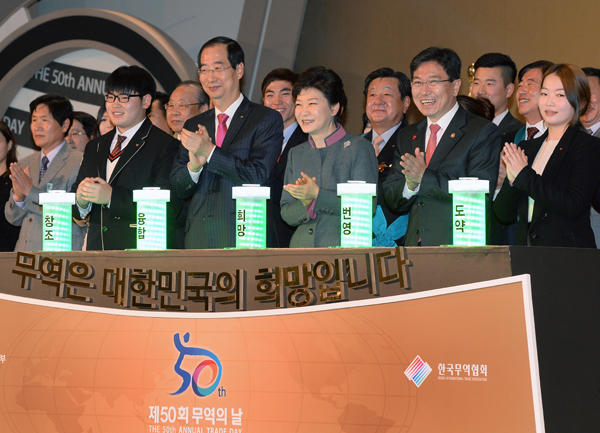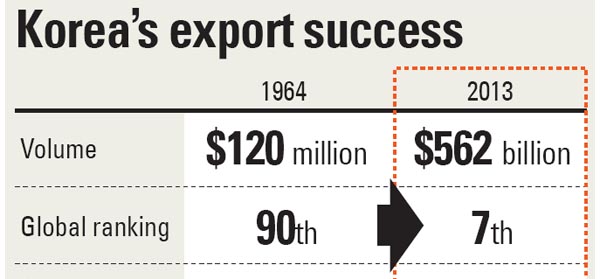Korea beats Japan in China trade

President Park Geun-hye, center, attends a ceremony held yesterday at COEX in Samseong-dong, southern Seoul, to celebrate the 50th anniversary of Trade Day. At the event jointly hosted by the Trade Ministry and the Korea International Trade Association, the government awarded 755 exporters medals. [Joint Press Corps]
* It has become the largest exporter to China, beating out Japan for the first time.
* It reached $1 trillion in trade volume for the third consecutive year.
* By the end of the year, it is expected to rack up its largest trade surplus ever.

The ministry said its strategy to diversify export markets, shifting the focus from advanced markets to emerging ones, has paid off.
In the 1990s, about 32 percent of Korea’s exports went to North America. This year, the percentage was down to 12 percent.
Instead, the proportion of exports going to Asian markets expanded to 60.5 percent.
“The country’s exports to China and other Asian countries are growing steadily,” the ministry said in a report.
“It is hard to accurately compare Korea’s export items to Japan’s, since the two countries’ export structures are quite different,” said an official at the ministry. “But we believe Korean mobile devices, whose exports to China grew a rapid 33 percent this year, has led the country to beat out Japan.”
Other top export items to China were semiconductors (which saw 18.6 percent year-on-year growth for the first 10 months), automobiles (29 percent) and ships (34.8 percent).
Trade Day was started in 1964 to celebrate the country reaching annual exports of $100 million for the first time. Since then, exports grew by an average of 19.2 percent every year until last year.
During the same period, total global exports rose 10.2 percent annually. Korea has been one of the fastest growing exporters for all five of the intervening decades.
As a result, Korea jumped from 90th place to seventh in terms of export volume, and now accounts for about 3 percent of the global market.
In terms of global trade, the country is the eighth largest trader.
This year, despite adverse market conditions, Korea’s trade volume surpassed $1 trillion again for the third consecutive year.
By the end of the year, the ministry forecasts that aggregate trade volume will reach $1.07 trillion, up slightly from $1.06 trillion last year.
The country is also expected to achieve its largest exports and trade surplus by the end of the year.
The Trade Ministry predicts total exports will grow from 2 percent to 2.5 percent, up to $560 billion this year, beating the previous record of $555 billion in 2011. The trade surplus is projected to be $43 billion, the largest since $41 billion in 2010.
To celebrate the 50 years of unstoppable trade, the Trade Ministry and Korea International Trade Association jointly held a ceremony at COEX in Samseong-dong, southern Seoul yesterday.
At the ceremony, President Park Geun-hye expressed gratitude to Korea’s traders for their hard work and contributions to the nation.
“I am thankful and proud of traders and other workers who made Korea what it is today,” Park said. “Although we anticipate gratifying records in trade this year, we can’t be complacent. I will set a new goal today. By 2020, Korea will be the fifth largest trading country and reach $2 trillion in annual trade volume.”
In her speech, Park recalled when Korea was selling wigs and iron ore as major products abroad.
Over the past 50 years, Korea’s export items have evolved in line with the development of the country’s industries.
In the early 1960s, plywood, wigs and iron ore were the main earners overseas. Iron ore was the top product of the decade. From 1970, Korea started selling some garments, including underwear and running shoes. Instant noodles were first sold outside of Korea in 1972.
In the 1980s, as Samsung Electronics kick-started its chip-making business, the country could start exporting DRAM chips. Sambo Engineering exported the country’s first personal computer. Hyundai Motor began selling vehicles in North America in the 1980s.
Mobile devices, including the world’s first CMDA cellular phones, were first exported in the 1990s.
Since 2000, cutting-edge mobile devices including smartphones, LCD displays and high-tech semiconductors are leading the nation’s exports. Some cultural and entertainment content is also going abroad as part of the Hallyu, or Korean Wave, of cultural exports.
At the COEX event, 755 exporters who contributed to trade were granted medals by the government. More than 1,500 businesses were given awards to commemorate their achievements. Five of them won the most honorable Gold Tower medal: Tata Daewoo Commercial, SK Energy, KMW, Hankook Machine Tools and Shinhung Global.
Next year, global economic conditions are forecast to be favorable for Korea’s exports, according to the Institute for International Trade at KITA.
The institute said in a report that exports would grow 6.4 percent in 2014 and imports 9.1 percent. It forecast a $33 billion trade surplus.
“Despite persisting uncertainties, the global economy is expected to recover backed by signs of recovery in the U.S. and euro zone economies,” said Oh Sang-bong, head of the IIT. “But the Korean currency may possibly be appreciating more against the yen and currencies of emerging countries, which each exporter needs to be aware of.”
BY SONG SU-HYUN [ssh@joongang.co.kr]










with the Korea JoongAng Daily
To write comments, please log in to one of the accounts.
Standards Board Policy (0/250자)